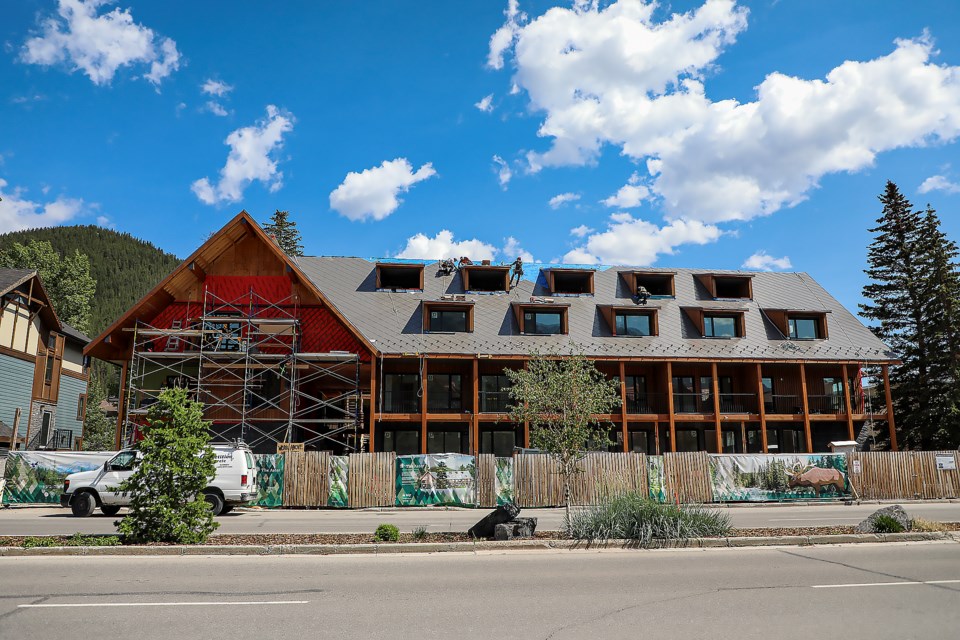BANFF – A new action plan to get more housing built in the Banff community calls for a full-scale review of the land use bylaw tied to housing and incentives to encourage development of more legal secondary suites.
The plan, approved by council on June 26, is a requirement in order for the Town of Banff to tap into a $4 billion nationwide federal initiative known as the Housing Accelerator Fund (HAF), aimed at driving housing construction across the country.
Town of Banff officials say some of these discussions have already started in council chambers, including parking requirements for housing and looking at municipally-owned lands for potential re-zoning to residential.
“The timing of the funding opportunity is very ideal because council has already started to discuss some of the items included in the proposed action plan,” said Alison Gerrits, a senior member of the housing team and community services director for the Town of Banff.
“The notable really being the amendments to the land use bylaw that would help to accelerate housing development within the community.”
As part of a bylaw review, the plan considers exploring conversion of existing non-residential lands to residential lands and amendments to permitted and discretionary uses, including making secondary suites a permitted use in all residential districts.
The plan also talks about reducing housing parking requirements and exploring options to increase existing floor area ratio, as well as changes to setback requirements, height allowances and site coverage to get more housing units built.
A program to encourage homeowners to develop accessory suites on their properties, such as basement suites or units over garages as examples, could include incentives like one-time cash grants and interest-free loans.
Exploring ways to fast-track development applications, which could include e-permitting, and looking at financial tools to drive constriction of more housing such as property tax strategies, cash-in-lieu and creation of developer incentives are part of the plan.
Lastly, it calls for hiring a three-year contract position under the HAF funding to act as a housing liaison with the municipality.
Mayor Corrie DiManno said the federal HAF initiative has potential “to help make transformational change in our community in a very serious way” and “feels like a once-in-a-generation opportunity.”
“Regardless of our application being successful or not, we are going to continue to tackle this head on,” she said.
“To receive this funding would help us be able to do that in a more aggressive way.”
The magnitude of potential funding for Banff could be game-changing, said DiManno, noting Banff is short 700 to 1,000 housing units and the recent resident satisfaction survey indicates housing is the No. 1 issue in the community.
“It could help us make a real tangible difference when it comes to the lack of affordable and available housing in Banff,” she said.
The turnaround time for the HAF submission is tight, with the portal expected to open shortly, giving municipalities a 45-day window to apply for funding.
The funds will be awarded four times over a three-year period and are based upon various milestones that are achieved throughout that time.
Once received, funds can be spent on any initiative included in a community’s action plan and approved by the Canada Mortgage and Housing Corporation (CMHC).
Similar housing plans have just recently been presented by neighbouring municipalities in Canmore and Calgary.
Gerrits said development of this housing action plan to satisfy the application requirements would complement, but not replace, any future development of a more comprehensive housing strategy for the town.
“Council has consistently identified lack of housing as one of its most pressing community issues,” she said.
“Even with all the activities and progress made, it is clear that more needs to be done to address the issue of lack of housing in the community.”
Gerrits said there is no guarantee the Town of Banff’s funding submission will be successful – it will be evaluated on a point system along with all others received – but successful applicants are expected to be notified in the fall.
“Due to the fact that CMHC has shared that the precise funding formulas have not been finalized or may change depending on the uptake of the program, it is very difficult to share a dollar amount that could be received by the municipality at this time,” she said.
On June 26, council also approved $100,000 from the cash-in-lieu housing reserve, which is not funded by general municipal taxes, to get a jump on some of the work should the municipality be successful. The balance in the reserve is $211,000.
While this is not a requirement of the HAF submission, Gerrits said the rationale is to fast-track some of the pre-development work needed to draft policy options and get ready for community consultation in fall.
“This will help to ensure the housing team is ready to go with a series of public consultation activities on the topic of housing as various decisions are furthered by council specific to housing policy,” said Gerrits.
DiManno said housing is not something that the municipality is able to tackle on its own, noting it is not financially viable on the existing tax base.
“We need to create those pathways for homeowners and private sector to be able to help us solve this issue,” she said.
“I think this could change the housing landscape as we know it for tomorrow and 10 years down the road.”




